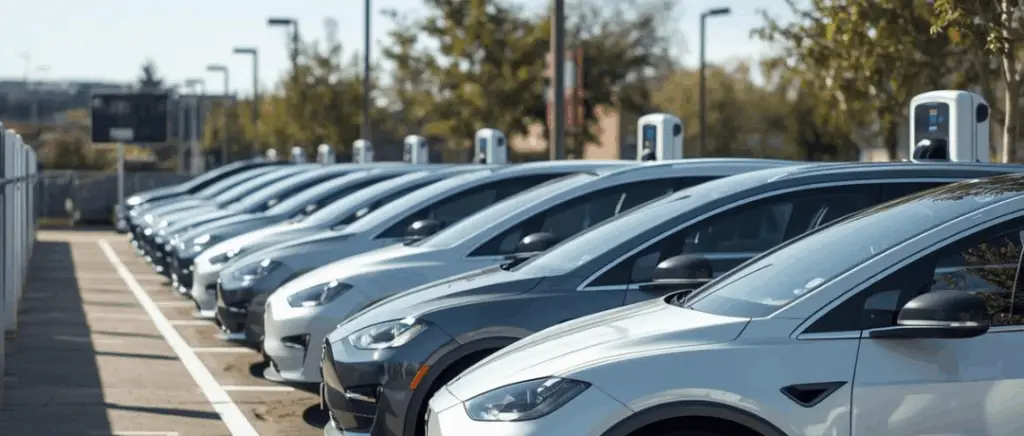Why are electric cars overtaking diesel today?
According to figures published by ACEA, the first eight months of 2025 saw electric vehicles (EVs) reach almost 16 % market share in Europecompared with 12.6 % over the same period last year. This rapid increase shows that 100 % electric vehicles are gradually gaining ground against diesel engines, which are now virtually on a par with plug-in hybrids (PHEV).
Key figures for the European and French markets
In detail, over this period, 1,132,603 new electric cars in battery were registered in the European Union. Of the four largest markets in the European Union, three countries recorded significant increases: Germany (+39.2 %), Belgium (+14.4 %) and the Netherlands (+5.1 %). At the same time, registrations of petrol cars fell by 19,7 % in the main markets, France in the lead (down 33.5 1Q3)followed by Germany (-25.2 %), Italy (-17.6 %) and Spain (-13.1 %).

Market share of registrations in Europe by energy source
Source : ACEA

Market share of registrations in France by energy source
Source : ACEA
The factors behind this transition to electric vehicles
This move towards electric vehicles can be explained by a number of factors specific to the needs of businesses. Firstly, the continuing fall in battery costs, combined with a wider range of 100 % electric vehicles.
Secondly, restrictions in low-emission zones (LEZs), which are now well established across Europe, are boosting interest in electric vehicles: diesel and petrol vehicles are increasingly restricted in city centres and on certain strategic roads, forcing companies to adapt their fleets to maintain their operations and deliveries.
La heavier diesel taxation is a major economic argument: taxes and costs linked to fossil fuels increase the total cost of ownership (TCO) of internal combustion vehicles, while EVs often benefit from tax breaks and VAT recovery schemes (for commercial vehicles).
Finally, theDirect savings on consumption and maintenance are strong arguments that have certainly helped to convince many companies in all sectors.
What does this mean for companies managing fleets?
Operational impact: more choice, more flexibility
Electrification is already transforming the daily lives of companies with large fleets of vehicles. The increased availability of electric vehicles, ranging from city cars to heavy commercial vehicles, means that almost all business needs can now be met. Advances inautonomy, often over 300 km for many recent commercial vehicles, making rounds and interventions more reliable, even outside urban areas.
At the same time, the network of recharging infrastructures is expanding rapidly, with faster public charging points, on-site recharging solutions and connected cables for top-up charging. These developments are reducing vehicle downtime and giving businesses greater flexibility in planning their journeys and operations.
A strategic lever for fleet managers
Fleets of electric vehicles reduce dependence on fossil fuelslimiting exposure to fluctuations in fuel prices and improving the total cost of ownership (TCO) a decisive asset in fleet budget management.
With electric vehicles, fleet managers' planning is both simpler and more predictable: they can anticipate long-term expenditure and limit the impact of fluctuating fuel prices. The rise of intelligent recharging solutions (off-peak scheduling, optimisation of available power) offers greater control over energy consumption and day-to-day operations.
French regulations have accelerated the electrification of professional fleets, in particular through the Mobility Orientation Act (LOM) and the Climate and Resilience Act. These texts set quantified and progressive objectives to oblige companies and administrations to integrate more sustainable development into their operations. low-emission vehicles (LEVs)emissions, i.e. vehicles emitting less than 60g of CO₂/km, including electric vehicles.
Renewal quotas imposed by the LOM
L'article 26A of the LOM provides that fleet renewalA growing proportion of low-emission vehicles must be integrated:
La Climate and Resilience Actpublished on 24 August 2021, has reinforced these objectives: 70 % of low-emission vehicles will have to make up the renewal of fleets by 2030, compared with the 50 % initially envisaged by the LOM.
| Application date | Minimum quota of low-emission vehicles in fleet renewals |
|---|---|
| 1ᵉʳ January 2022 | 10 % |
| 1ᵉʳ January 2024 | 20 % |
| 1ᵉʳ January 2027 | 40 % |
| 1ᵉʳ January 2030 (LOM) | 50 % |
| 1ᵉʳ January 2030 (Climate) | 70 % (new objective strengthened by the Climate and Resilience Act) |
Mandatory declaration for certain companies
Companies and administrations with at least 100 vehicles must declare each year the greening rate of their fleet.
This declaration must be made before 30 September for the previous calendar year via the official platform : data.gouv.fr.
Anticipate to remain compliant and avoid penalties
These obligations require fleet managers toanticipate their renewals These include respecting quotas at every stage and planning electrical acquisitions over the medium term. The earlier the company prepares for electrification, the more likely it is to avoid additional costs and possible future penalties linked to non-compliance with quotas or late compliance.
Greening your fleet, a lever for tax optimisation in 2025
La Annual Incentive Tax for Greening (TAI)which came into force on 1ᵉʳ March 2025is a new key step in the energy transition for commercial fleets. It applies to all French companies managing more than 100 vehiclesThese include both passenger cars and light commercial vehicles.
The aim of this tax is clear: to speed up the greening of vehicle fleets by replacing the quota system imposed by the LOM. From now on, companies must include a minimum percentage of low-emission vehicles (LEVs) in their fleets each year. If these thresholds are not met, financial penalties will apply, with a direct impact on fleet managers' budgets.
Deadlines set by the legislator
TAI sets a precise timetable for the greening thresholds to be met
| Year | Minimum proportion of low-emission vehicles (LEVs) in the fleet |
|---|---|
| 2025 | 15 % |
| 2026 | 18 % |
| 2027 | 25 % |
| 2028 | 30 % |
| 2029 | 35 % |
| 2030 | 48 % |
To remember: the earlier a company reaches these thresholds, the more it will reduce its tax liability, or even avoid it altogether.
Obligations relating to recharging infrastructure
TAI is accompanied by a more stringent requirements for recharging stations in company car parks:
- A car park for 60 seats must have at least 3 terminalsof which 1 PMR terminal (people with reduced mobility).
- La minimum recommended power for these recharging points is set at 22 kW to meet the needs of fleets.
These measures require companies to anticipate both the gradual integration of EVs and the deployment of their recharging infrastructure.
Monday to Friday, 9am to 12.30pm and 2pm to 7pm
The financial impact of non-compliance
Companies that do not meet the targets set by the TAI will see their tax burden increase, while those that anticipate the electrification of their fleet will reduce or abolish this tax.
Electrifying your fleet therefore becomes a lever for tax optimisation: an initial investment that translates into a direct gain in annual tax, in addition to the reduction in the cost of electricity. total cost of ownership (TCO) already seen on electric vehicles.
How does electrification improve competitiveness and brand image?
The electrification of a fleet is no longer just a technological choice: it has become an essential part of our daily lives. strategic advantage for companies faced with increasingly stringent environmental requirements.
A decisive advantage in calls for tender
An increasing number of calls for tender, particularly from the public sector, now include mandatory environmental criteria. Companies need to be able to measure and justify their carbon footprintOtherwise they risk being excluded from a contract.
This development has been reinforced by a number of regulatory measures:
- La CSRD (Corporate Sustainability Reporting Directive), supplemented by the Omnibus regulation, requires European companies to publish detailed data on their environmental impact.
- Le BEGES (Bilan des Émissions de Gaz à Effet de Serre), which has become compulsory for a growing number of economic players, is the essential starting point for managing and reducing emissions.
In this context, having aelectric fleetis becoming a powerful argument for winning contracts, by meeting the low-carbon requirements of clients.
Contributing to carbon neutrality and ESG commitments
The transport sector alone accounts for almost a third of France's greenhouse gas emissions. The electrification of fleets is therefore a major lever for decarbonisation.
According to ADEME, an electric car emits an average of 103g of CO₂e/km, i.e. 2 to 3 times less than an electric car. thermal vehicle throughout its life cycle.
By adopting electric vehicles, companies are directly reducing their emissions and contributing to their ESG and carbon neutrality objectives, indicators that are increasingly scrutinised by investors and financial partners.
A lever for promoting CSR to customers and partners
With Beev
Switch to
Electric cars
or install your
Charging station
For individuals and businesses
Electrification also enhances the credibility of CSR initiatives by demonstrating a concrete commitment to the climate. This sends out a strong signal to customers, partners and employees, improving both the company's brand image and reputation.
What are the strategies for successfully rolling out a large-scale electric fleet?
Going electric means more than just replacing internal combustion vehicles with EVs. To make a successful large-scale transitionyou need a structured strategy to optimise investment, ensure operational continuity and maximise environmental and financial benefits.
Carrying out an audit and mapping usage
The first step is to analyse the fleet's real needs:
- Study journey profiles (average mileage, geographical areas, frequency of stops).
- Assess current energy consumption and operating costs.
- Identify priority vehicles for electrification, based on their age, TCO and carbon impact.
This mapping enables a progressive conversion plan to be defined, tailored to the company's operational and budgetary constraints.
Choosing the right models for every purpose
Once the diagnosis has been made, it is essential to select the right EV models for the job:
- City cars or light commercial vehicles for short urban journeys.
- Long-range commercial vehicles or vans for long-distance routes.
- Specific vehicles for construction and logistics, compatible with heavy loads.
The aim is to guarantee the versatility and productivity of the fleet while avoiding oversizing the batteries, which increases the cost and weight of the vehicles.
Anticipating charging infrastructure
The success of electrification depends on the availability and performance of charging points:
- Fixed charging points at main sites for night-time recharging or scheduled rotation.
- Mobile, connected charging cables for on-site work or off-grid tours.
- Intelligent recharging control solutions to smooth consumption peaks and reduce energy bills.
Precise infrastructure sizing avoids bottlenecks and guarantees optimum service continuity.
Supporting change management
Deploying a successful electric fleet also involves people:
- Train drivers in electric eco-driving to optimise range and reduce battery wear.
- Implement real-time monitoring tools (telematic platforms, energy performance indicators).
- Involve operational teams from the pilot phase onwards to encourage buy-in and identify areas for improvement.
Combining a technical approach, human support and budget planning to ensure a smooth and sustainable transition.
The European automotive market is showing a clear shift: electric vehicles are gradually overtaking diesel, confirming that the energy transition is underway. Professionals are no longer simply spectators to this change: they have become major players in this transformation, playing a decisive role in decarbonising transport and optimising fleets.
Between regulatory compliance and strategic opportunities (reduced TCO, competitive tendering, ESG criteria), companies that green their fleets have everything to gain.
And what about you? Are you ready to seize the opportunities offered by the transition to electric mobility?
You would like toto electric?
Beev offers multi-brand 100% electric vehicles at the best prices, as well as recharging solutions.
































